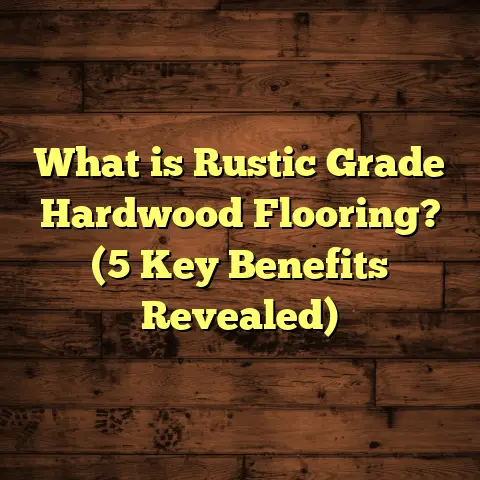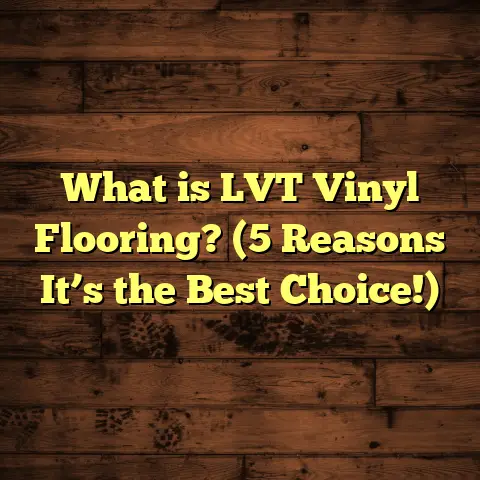What is Interlocking Vinyl Flooring? (5 Key Benefits Revealed!)
I remember the first time I stepped into a home with interlocking vinyl flooring. The floor looked smooth, clean, and modern—yet it wasn’t cold like tile or noisy like hardwood sometimes can be. It gave the space a warm, inviting feel that I instantly loved. If you’re curious about what interlocking vinyl flooring is and whether it might be a good fit for your home, let me share what I’ve learned over the years both as a contractor and someone who’s gone through the process personally.
What is Interlocking Vinyl Flooring?
At its core, interlocking vinyl flooring is a type of resilient flooring made from synthetic materials. The key feature is in the way the planks or tiles fit together—they have a locking mechanism along the edges, usually shaped like tongues and grooves, that snap into place without needing glue or nails. This “click-lock” design makes installation straightforward and often doable for DIY enthusiasts.
Unlike traditional vinyl sheets that come in large rolls and require adhesive, interlocking vinyl comes as individual planks or tiles. These pieces mimic the look of real wood, stone, or ceramic but with the added benefits of vinyl’s waterproof and durable nature. The surface is typically coated with a wear layer that protects against scratches, stains, and everyday wear.
Why does this matter?
Because of the interlocking system, you can install the floor over many types of existing surfaces with fewer prep steps. This flexibility is a game-changer in both renovation projects and new builds.
Breaking Down the Components
Let me break down what exactly you get with interlocking vinyl flooring:
- Core Layer: This is the backbone of each plank. It can be flexible or rigid. Rigid cores often contain materials like limestone composites or WPC (wood plastic composite), which add sturdiness.
- Vinyl Wear Layer: This transparent layer protects the design from scratches, stains, and fading. The thickness can vary—from about 6 mils (thousandths of an inch) for homes to over 20 mils for commercial use.
- Design Layer: Printed images on this layer give the floor its appearance—wood grains, stone patterns, or even abstract designs.
- Backing Layer: The bottom layer stabilizes the plank and sometimes includes padding for sound absorption and comfort.
Understanding these layers helps explain why interlocking vinyl flooring can be so durable yet comfortable.
5 Key Benefits of Interlocking Vinyl Flooring
1. Easy Installation – No Fuss, No Mess
One of the best things I appreciate about interlocking vinyl flooring is how simple it is to install. I remember helping a friend lay down this type of floor in her kitchen. We finished in just a day, no special tools required beyond a utility knife and a tapping block.
The interlocking edges click together firmly, so the planks stay put without adhesive. This floating floor system means you can even walk on it right after installation. The precision of the locking mechanism eliminates gaps and movement between planks over time.
Data point: According to industry averages, interlocking vinyl floors can be installed 30-50% faster than traditional glued vinyl sheet floors, saving significant labor costs and time.
Step-by-Step Installation Process
If you’re considering doing this yourself, here’s how installation typically goes:
- Prepare the Subfloor – Clean and level the surface. Minor imperfections can be fixed with patching compounds.
- Acclimate the Flooring – Leave the planks in your home for 48 hours to adjust to room temperature.
- Lay Underlayment (if needed) – Some vinyl floors come with attached padding; otherwise, lay a suitable underlayment for sound reduction.
- Start Laying Planks – Begin in one corner, working left to right. Align tongues and grooves carefully.
- Cut to Fit – Use a utility knife to trim planks at edges and around obstacles.
- Finish Edges – Install baseboards or molding to cover expansion gaps.
This process can be done in any room with minimal disruption.
Personal Experience: The DIY Thrill
When I helped my sister install her living room floor with interlocking vinyl, she was amazed at how quickly progress was made without waiting on glue drying times or dealing with fumes. We even had a few laughs over some tricky cuts near door jambs. That hands-on experience convinced me even more that this flooring type makes renovation approachable for most homeowners.
2. Durability That Stands Up to Life
I’ve seen homes with pets, kids, and heavy foot traffic still maintain their interlocking vinyl floors looking great after years. The wear layer on these floors can range from 6 mils for residential use to 20 mils or more for commercial-grade options. This means they resist scratches, dents, stains, and fading much better than many other flooring types.
For example, in one project I worked on in a busy daycare center, the commercial-grade interlocking vinyl flooring held up perfectly for over five years with daily foot traffic and spills.
How Durable Are We Talking?
Vinyl floors with wear layers of 12 mils or more have been tested to withstand:
- Heavy rolling loads (think office chairs on casters)
- Sharp objects (pets’ claws included)
- Frequent cleaning chemicals
- UV exposure without discoloration
This is backed by lab testing such as ASTM F1514 standards that measure abrasion resistance.
Real-Life Case Study: A Restaurant Kitchen
I consulted on a restaurant kitchen renovation where durability was critical due to spills, dropped utensils, and constant foot traffic. The owners chose commercial interlocking vinyl planks rated at 20 mils wear layer thickness.
After two years of continuous use, inspections showed minimal wear marks or surface damage—a huge improvement over their previous ceramic tile floor that cracked repeatedly.
3. Waterproof Wonder for Wet Areas
If you’ve ever dealt with water damage on hardwood floors or swelling laminate planks, you know how frustrating it can be. Interlocking vinyl flooring is naturally waterproof because vinyl itself doesn’t absorb water.
While some interlocking systems have tiny gaps at the seams where water could seep in if not sealed properly, many manufacturers now offer waterproof locking edges or provide optional waterproof sealants to apply after installation.
Why Does Waterproof Matter?
Moisture problems can cause warping, mold growth, and structural damage with many other flooring types. For areas like bathrooms, kitchens, basements, or laundry rooms—where spills and humidity are everyday facts—having waterproof floors means peace of mind.
Personal note: I installed interlocking vinyl in my basement laundry room where moisture was always a concern. After nearly three years, no signs of warping or mold have appeared—even after occasional flooding.
Additional Waterproof Features
Some advanced designs include:
- Waterproof cores: Materials like SPC (stone plastic composite) are extremely resistant to moisture.
- Seam sealing tapes: Applied underneath joints for extra protection.
- Overlap locking profiles: Designed to prevent water seepage between planks.
4. Comfortable Underfoot + Noise Reduction
Hard surfaces like tile or hardwood can feel cold and echoey underfoot. Interlocking vinyl flooring has a slight give due to its core construction—usually made from materials like PVC or composite layers—which makes it softer to walk on.
This cushioning effect reduces fatigue if you stand for long periods, which I find important when cooking or working in busy areas at home.
Also, because the planks snap tightly together over an underlayment (or sometimes have built-in padding), they absorb sound better than hard tile or stone floors.
Scientific Support for Comfort
Studies measuring floor comfort index show that resilient floors like vinyl reduce pressure on joints by about 15-20% compared to hard tile floors.
This means less strain when standing or walking long distances inside your home.
Noise Reduction Benefits
In multi-level homes or apartments, reducing noise transmission can improve quality of life for everyone.
Statistic: Studies show that homes with vinyl flooring report up to 25% less footstep noise compared to typical hardwood installations.
I’ve installed this type of flooring in upstairs bedrooms where noise was previously an issue—and clients reported noticeably quieter spaces afterward.
5. Stylish Looks Without Breaking the Bank
I love how far vinyl flooring has come in terms of aesthetics. Interlocking vinyl planks can mimic natural wood grains, slate textures, and even concrete finishes with incredible realism. This opens up many design possibilities without paying a premium price.
When I helped redo my sister’s living room floor last year, she chose a light oak-look vinyl that transformed the space from dark and dated to bright and modern—all under budget compared to hardwood or tile options.
Variety Is the Spice of Design
With so many patterns available—from rustic barn wood looks to sleek urban stone—you can match almost any interior style:
- Rustic farmhouse
- Modern minimalist
- Coastal chic
- Industrial loft
- Traditional elegance
Vinyl also allows experimenting with bold colors or geometric patterns that might be too costly in natural materials.
Price Comparison Breakdown
| Flooring Type | Material Cost (per sq ft) | Installation Cost (per sq ft) | Total Average Cost (per sq ft) |
|---|---|---|---|
| Interlocking Vinyl | $3 – $7 | $2 – $5 | $5 – $12 |
| Hardwood | $5 – $10 | $3 – $7 | $8 – $17 |
| Tile (Ceramic/Porcelain) | $4 – $8 | $5 – $10 | $9 – $18 |
| Laminate | $2 – $6 | $2 – $4 | $4 – $10 |
You can see how interlocking vinyl fits nicely into mid-range budgets while delivering premium looks.
How I Use Tools Like FloorTally for Cost Estimation
If you’ve ever tried guessing what a flooring project will cost, you know how tricky it can be to account for all variables—material choices, labor rates in your area, waste factor, and more. When I plan installations (either for clients or myself), I rely on tools like FloorTally.
With FloorTally, I enter my room dimensions and select materials from their extensive list. It factors in local prices based on my zip code and even includes labor estimates if I’m hiring professionals. What’s really handy is the waste calculation—flooring often requires ordering extra material to cover cuts and mistakes.
By using this tool early on, I avoid surprises later and can adjust my choices to fit my budget without compromising on quality or style.
A Real Example Using FloorTally
For my sister’s living room project:
- Room size: 300 sq ft
- Chosen material: mid-grade oak-look interlocking vinyl
- Estimated waste factor: 10%
- Local labor rate: $3 per sq ft
FloorTally gave me:
- Material cost: ~$1,800
- Labor cost: ~$900
- Total: ~$2,700
This was right on target with her budget after some minor tweaks to product choice.
My Experience with Interlocking Vinyl Flooring: A Story
A couple of years ago, I was hired to renovate an older home where the original hardwood floor had been damaged by water in several spots. The homeowners wanted something durable but didn’t want to spend too much or lose the warm look of wood.
After discussing options, we settled on an interlocking vinyl plank floor with a distressed wood look. The installation took two days. Watching those dull spaces transform into cozy rooms made me appreciate how versatile this flooring really is.
Since then, those homeowners have told me how easy it’s been to clean—just sweeping and occasional mopping—and how their floor looks as good as new even after two years of daily use by their energetic kids and pets.
Unexpected Benefits They Noticed
They mentioned:
- Reduced noise during playtime upstairs
- Warm feel during colder months
- No worries about spills ruining their floor
It’s rewarding when a project delivers beyond just looks.
What Types of Spaces Benefit Most from Interlocking Vinyl Flooring?
So where does this flooring really shine? Here are some examples based on my jobs and research:
- Kitchens & Bathrooms: Water resistance keeps these high-moisture areas safe from damage.
- Basements: Moisture-prone but great for comfort compared to cold concrete.
- Rental Properties: Durable surface withstands tenant turnover wear.
- Kids’ Playrooms: Easy cleanup from spills and scratches.
- Home Gyms: Cushioning underfoot protects joints during workouts.
- Offices & Retail Spaces: Commercial-grade options handle heavy traffic while looking professional.
- Entryways & Mudrooms: Resistant to dirt and easy to clean after outdoor exposure.
Each space has unique demands that interlocking vinyl meets well.
Maintenance Tips That Keep Your Floor Looking New
One thing clients often ask me: “How do I keep my interlocking vinyl flooring looking great?”
Here are some tips I always recommend:
- Sweep or vacuum regularly to remove grit that can scratch.
- Mop with mild cleaners designed for vinyl floors—avoid harsh chemicals.
- Wipe up spills quickly to prevent stains.
- Use felt pads under furniture legs to avoid dents.
- Avoid dragging heavy items across the floor; lift instead.
- Avoid excessive water pooling; wipe dry if needed.
A little care goes a long way with these floors because their surface is designed to be tough but not indestructible.
Cleaning Products I Recommend
I usually suggest brands made specifically for resilient floors that don’t leave residues or dullness behind. Avoid ammonia-based cleaners which can degrade the wear layer over time.
Troubleshooting Common Issues with Interlocking Vinyl Flooring
While this flooring is great overall, some challenges might come up:
Gapping Between Planks
Fix: Adjust expansion gaps or use transition moldings; ensure proper acclimation before installation.
Peaking or Buckling
Planks might lift if there’s moisture trapped underneath or if the subfloor isn’t flat.
Fix: Remove affected sections; check subfloor moisture; reinstall correctly with proper leveling.
Surface Scratches
Though wear layers are tough, sharp objects can still scratch.
Fix: Use repair kits designed for vinyl scratches; prevent by placing mats at entryways.
Environmental Impact & Sustainability Considerations
You might wonder about eco-friendliness. Vinyl is synthetic but modern manufacturing has improved:
- Some brands use recycled content in cores.
- Vinyl floors are long-lasting so fewer replacements needed.
- Many products are recyclable at end-of-life through special programs.
- Low VOC emissions contribute to healthier indoor air quality compared to some other synthetic floors.
Always check product certifications like FloorScore or GREENGUARD when shopping if sustainability matters to you.
My Recommendations When Choosing Interlocking Vinyl Flooring
If you decide this floor suits your needs:
- Prioritize wear layer thickness matched to your expected traffic.
- Choose rigid core options for added durability in high-use areas.
- Check warranty details—most offer 10+ years residential coverage.
- Select textures that help hide scratches (matte finishes work well).
- Get samples first—lighting can affect color perception greatly.
- Consider professional installation if you want guaranteed precision and warranty protection.
- Use tools like FloorTally early on for budgeting clarity.
- Prepare your subfloor carefully—cleaning and leveling pay off big time in results.
- Plan for expansion gaps per manufacturer instructions.
- Think about underlayment options if sound reduction is important in your space.
Bonus: Comparing Interlocking Vinyl Flooring vs Other Popular Floors
| Feature | Interlocking Vinyl | Hardwood | Laminate | Tile |
|---|---|---|---|---|
| Installation Ease | Easy DIY | Moderate (nail/glue) | Easy DIY | Difficult (grout/tile cuts) |
| Waterproof | Yes | No | No (unless waterproof core) | Yes |
| Durability | High | High but scratch-sensitive | Moderate | Very High |
| Comfort | Soft/Flexible | Hard | Hard | Hard |
| Noise Reduction | Good | Moderate | Moderate | Poor |
| Cost | Moderate | High | Low-Mid | Mid-High |
| Aesthetic Variety | Wide | Natural wood beauty | Wood/stone look | Natural stone/tile look |
| Maintenance | Low | Moderate | Moderate | Moderate |
Wrapping Up My Thoughts on Interlocking Vinyl Flooring
Choosing flooring isn’t just about looks—it’s about lifestyle fit too. Interlocking vinyl offers versatility few other options match: fast installation; durability under pressure; waterproof reliability; comfort beneath your feet; and style flexibility—all at reasonable cost.
This flooring type has proven itself over many projects I’ve handled personally—from busy family homes to commercial spaces requiring heavy-duty wear resistance—and it rarely disappoints.
If you want more specific advice tailored to your project size or style preferences—or help crunching numbers using tools like FloorTally—I’m here to chat anytime!
What questions do you have? Or maybe you want tips on installation tricks? Let’s talk floors!





